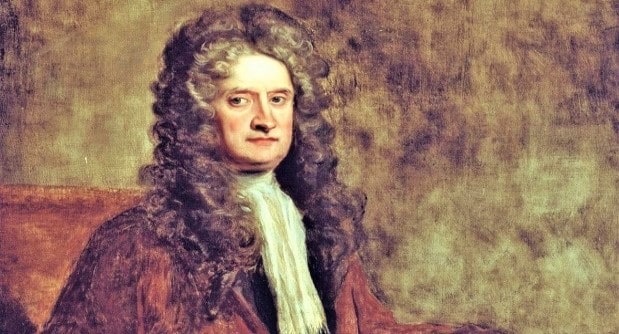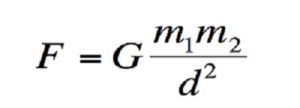
Isaac Newton (Born on December 25, 1643, in Woolsthorpe, Lincolnshire; and died on March 20, 1727), was a physicist, theologian, inventor, alchemist, and English mathematician. He is the author of the Philosophiæ Naturalis Principia Mathematica, better known as the Principia, where he describes the law of universal gravitation and established the foundations of classical mechanics through the laws that bear his name.
His other scientific discoveries include works on the nature of light and optics (which are mainly presented in his work Opticks), and in mathematics, the development of infinitesimal calculus. Newton shares with Gottfried Leibniz the credit for the development of integral and differential calculus, which he used to formulate his laws of physics and astronomy.
He also contributed to other areas of mathematics, developing the binomial theorem and the Newton-Cotes formulas. Among his scientific findings is the discovery that the color spectrum seen when white light passes through a prism is inherent in that light, rather than coming from the prism (as had been postulated by Roger Bacon in the 13th century).; his argument about the possibility that light was made up of particles; his development of a thermal convection law, which describes the cooling rate of objects exposed to air; his studies on the speed of sound in air; and his proposal for a theory on the origin of stars.
He was also a pioneer of fluid mechanics, establishing a law on viscosity. Newton was the first to demonstrate that the natural laws that govern the motion on Earth and those that govern the motion of celestial bodies are the same.
He is often rated the greatest scientist of all time, and his work the culmination of the scientific revolution. Mathematician and physicist Joseph Louis Lagrange (1736-1813) said that “Newton was the greatest genius ever, and also the most fortunate, given that only one system can be found to rule the world.”
The Early Life of Isaac Newton
Isaac Newton was born in Woolsthorpe-by-Colsterworth, Lincolnshire, on 25 December 1642 Julian, or 4 January 1643, in a family of breeders. His father, also named Isaac and a small landowner, died three months before his birth; he, on his will, drew a bird as his hallmark instead of the signature, despite being able to write.
Three years later, her mother, Hannah Ayscough, remarried a wealthy cleric named Barnabas Smith, sixty years old, leaving little Isaac in the care of his maternal grandparents. In those years he was very unhappy: he hated his stepfather and it seems that once he came to threaten to set his house on fire.
In 1652, when Isaac was ten years old, his stepfather died leaving him a not indifferent legacy with which he could pay for education at King’s School, in Grantham. He was staying with the Clarke family, in close friendship with the Newtons. It seems to have had a romantic relationship with Catherine Storer, the landlord’s stepdaughter.
It was probably not an important thing, but it was practically the only romantic relationship Newton had in his life. During that time he had taken strange habits: he built sundials, water hourglasses and working models of mills.
At the end of 1658, his mother forced him to abandon his studies and called him home to take care of the fields but turned out to be a bad farmer. Eventually, his teacher convinced his mother to let him continue his studies at Trinity College in Cambridge where he moved in 1661.
At that time the College’s teachings were based on Aristotle, but Newton preferred more modern philosophers such as Descartes, Galileo, Niccolò Copernico, and Keplero. In 1665 he obtained the Bachelor of Arts; in 1666 he was elected Junior Fellow. In 1668 he obtained the title of Master of Arts and became Senior Fellow of Trinity College (Cambridge).
First contributions
From the end of 1664, he worked intensively on different mathematical problems. He then approached the binomial theorem, based on the work of John Wallis, and developed his method called calculation of fluxions. Shortly afterward, she returned to the family farm due to an epidemic of bubonic plague.
Retired with his family between 1665 and 1666, he underwent a very intense period of discoveries, among which the law of the inverse of the square of the distance in gravitation, his development of the bases of classical mechanics, the formalization of the fluxion method stand out and the generalization of the binomial theorem, also highlighting the physical nature of colors.
However, he was silent for a long time about his discoveries in fear of criticism and theft of his ideas. In 1667 he resumed his studies at Cambridge University.
The Universal Law of Gravitation
In January 1684, Robert Hooke, Christopher Wren, and Edmond Halley discuss the movement of the planets. The three men agree that the Sun attracts planets with a force inversely proportional to the square of their distance.
The question they ask is that of the orbit that a planet subject to the influence of this force will follow; by sheltering behind Kepler’s laws, they imagine that it will be an ellipse, but they lack the tools to demonstrate it. Hooke announces that he has found the solution, but refuses to reveal it until the other two admit defeat.
Halley and Wren admit their failure, but the months pass and Hooke still does not reveal his secret. So Halley decides to ask Isaac Newton the question, in the presence of the mathematician Abraham de Moivre- a friend of Newton – whose memories are the most reliable. Newton immediately replied that it would be an ellipse because he calculated it.
When Halley wants to see the calculations, Newton assures him that he has lost them. Richard S. Westfall (1924-1996), Newton’s biographer, maintains that this excuse is not very credible since the manuscripts containing the calculations in question are kept today.
Anyway, in November, Halley receives a brief nine-page manuscript called De Motu corporum in Gyrum (From the movement of bodies in orbit) where he finds what he expected, and much more than that: a draft of the general science of dynamics. Halley receives permission from Newton to comment to the Royal Society on the work which, will be published two years later.
Newton thus discovers the universal law of gravitation or universal attraction as the cause of the movements of the planets, thus unifying terrestrial mechanics and celestial mechanics. He expresses this law in a simplified way by the following mathematical expression:

where:
- F→g: It is the vector gravitational force. Its unit of measurement in the International System is the newton (N)
- G is the universal gravitation constant, which does not depend on the interacting bodies and whose value is G = 6.67 · 10 -11 N · m 2 / kg 2,
- M1 and M2 are the masses of the interacting bodies. Its unit of measurement in the International System (SI) is the kilogram (kg)
- D is the distance that separates them. It is the module of the vector→ , which unites the mass that generates the force with the mass on which it acts.
- or→r it is a unitary vector that has the same direction of action of the force although in the opposite direction.
Newton’s Three Laws
Isaac Newton published these laws in 1687, in his three-volume work entitled Mathematical Principles of Natural Philosophy. The laws explained various behaviors related to the movement of physical objects and it was an extensive work in which he dedicated himself:
- The first law says that “a body at rest remains at rest if it is not forced to change, a body that moves will continue to move at the same speed and in the same direction if it is not forced to change”.
- The second law “shows that the amount of force can be measured by a proportion of change observed in the movement”. This proportion is what is called acceleration and refers to the speed of increase or decrease in speed.
- The third law says that “every action causes a reaction, and that the action and the reaction are the same and the opposite”.
Positions and honor
In 1667, when the university reopened, Newton returned to his secondary teaching activity, but soon progressed and at the age of 26, he became a professor of mathematics, succeeding his own master and protector Isaac Barrow.
In 1672 he was elected to the Royal Society. He represented Cambridge University in Parliament twice, from 1689 and 1690 and in 1701.
He was director of the Casa da Moeda, a time when he strengthened the currency and raised and national credit. In 1705, Queen Anne granted Newton the title of “Sir”. He was the first scientist to receive such an honor.
The last years of Isaac Newton life
Isaac Newton spent the rest of his scientific life expanding his discoveries. He dedicated himself to researching light rays. It concluded that light is the result of the rapid movement of an infinity of tiny particles emitted by a luminous body.
At the same time, he discovered that white light results from the mixture of the seven basic colors. He invented a new mathematical system for infinitesimal calculations, perfected the manufacture of mirrors and lenses, manufactured the first reflecting telescope.
He discovered the laws that govern tidal phenomena, at a time when economic activities depended on maritime navigation. Isaac Newton made predictions for the end of the world based on biblical scriptures, especially on the book of Daniel, and that the event would be in 2060, on the Gregorian calendar.
Isaac Newton passed away in London, on March 20, 1727. His funeral was grand. Six noble members of the English Parliament carried their coffins to Westminster Abbey, where their remains rest today. In his honor, a statue was erected in Cambridge with the words: “It has surpassed humans by the power of its thought“.
[…] Charles Darwin died in Down, County Kent, on April 19, 1882. Although he assumed that he was buried in the cemetery of St. Mary in Down, at the request of Darwin’s colleagues, the president of the Royal Society, William Spottiswoode, arranged a state funeral for Darwin. He was buried in Westminster Abbey near the grave of Isaac Newton. […]